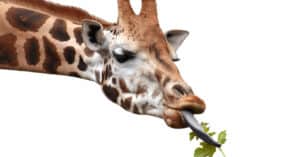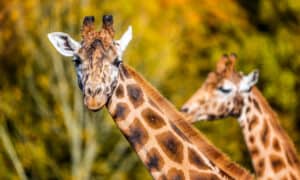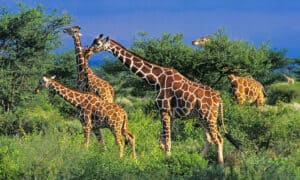Giraffes are most well-known for their long necks and legs. However, another distinctive feature of the tallest animal on Earth is certainly their spots. These spots, or patches, cover their bodies from head to toe and appear in innumerable combinations of shapes, patterns, and shades. While the patterns certainly look pleasing to the eye, their primary purpose is not simply cosmetic. On the contrary, giraffe’s spots serve several crucial functions that raise a giraffe’s chances of survival. What seems like a mere splash of color runs more than skin deep. Indeed, giraffes’ spots reveal incredible details about their anatomy, evolution, and social structure.
Why Giraffes Have Spots
No two giraffes possess the same coat markings. In addition, different subspecies of giraffes tend to exhibit different groups of patterns and shades. While debates continue as to the exact number of giraffe subspecies, there is consensus concerning nine recognized subspecies. These include the Reticulated, Nubian, Angolan, West African, South African, Masai, Thornicroft’s, Kordofan, and Rothschild’s giraffes. Each of these giraffes displays distinctive patterns that help to identify them from other subspecies. For example, Kordofan giraffes have more irregular spotting patterns. In addition, their spots can be found below the hocks and the insides of their legs. Meanwhile, Nubian giraffes normally possess prominent chestnut-colored spots but spotless undersides. Then there are Masai giraffes, which sport irregular, star-like spots all the way to their hooves. Finally, Angolan giraffes contain spots on their legs but not on their faces.
For years, scientists wondered why these patterns differed and what they meant. Now, thanks to recent studies and marking analysis, we better understand why these spots exist and the purposes they serve. According to a study from 2018, baby giraffes obtain their marking patterns from their mothers. In total, scientists identified 11 different attributes that can be used to differentiate spots, including size, shape, color, outline, pattern, and distribution. Characteristics such as roundness and smoothness correlate highly in mother-infant pairings, which suggests that giraffes inherit their spots. While scientists may never know exactly why or how giraffes get their spots, three prevailing theories currently dominate the conversation. They include spots as camouflage, spots as signs of social makings, and spots as heat regulators. Let’s take a look at each of these functions and see how they help giraffes survive and what could underpin their development.
Spots as Camouflage
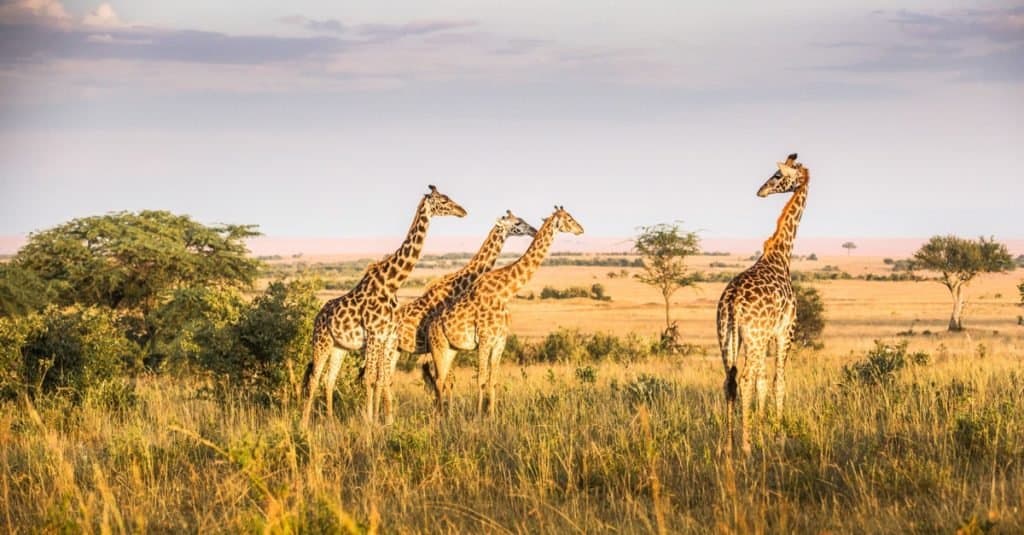
The spots on a giraffe help it to blend into its surroundings.
©Ketan shah/Shutterstock.com
Many animals evolved spots as a form of camouflage. Patterns such as stripes and spots allow animals with camouflage to blend into their surroundings, which can help them to avoid detection from a hunter or the hunted. For example, predators evolved spots to better stalk their prey, while prey evolved spots to hide from predators. Animals developed unique spots and colorings to match their environment, which explains why such a wide variety of patterns exist. From dark to light to brightly colored hues, animals evolved spots to match their habitat, enabling them to better survive in that particular area.
In the case of giraffes, the primary reason why they developed their spots is likely as a form of camouflage. Their pattern allows them to blend in with the yellow and brown landscape common across Africa’s savannahs. Overall, the color of a giraffe’s spots normally matches the coloring of the vegetation that grows in its native habitat. This suggests that spots evolved in response to environmental stimuli which increased giraffes likelihood of surviving and bearing offspring with similar markings. Furthermore, researchers identified that certain patterns tend to convey a greater likelihood of survival to infants than others. In particular, calves with larger, more irregularly-shaped spots were more likely to survive than calves with smaller, more uniform makings. This selection for diversity and uniqueness is likely why so many different patterns exist today and why no two giraffes look exactly alike.
Spots as Social Markings
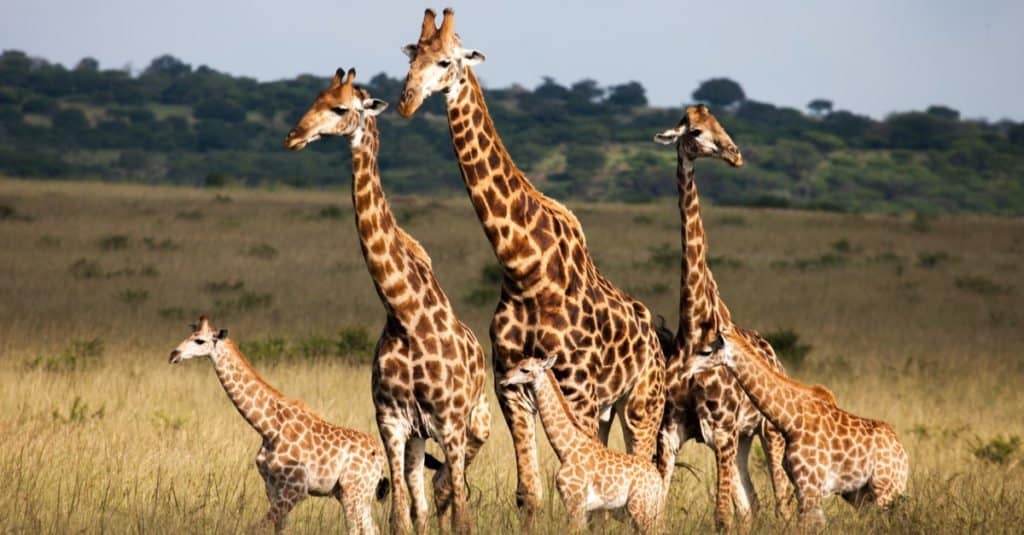
Calves inherit their spots from their mothers, which helps the mothers to identify their calves in a group.
©Craig Fraser/Shutterstock.com
Another reason why giraffes have spots has to do with their role as social markings. Since calves often inherit their mother’s pattern, this makes it easy for mothers to identify their offspring in a mixed group. Giraffes live in herds of 10 to 20 individuals, which means that differentiating characteristics serve an important role in helping giraffes tell each other apart. The more easily a mother can visualize her calf, the easier it is to keep it from danger. Just imagine if all giraffes bore the same pattern, and how difficult that would make it for mothers to single out their calves. By evolving distinct markings, and then passing these markings on to their offspring, giraffe mothers developed a way to keep an eye on their young. This adaptation likely greatly benefits caring mothers with strong maternal instincts whose offspring earn a higher likelihood of growing to reach adulthood.
Spots as Heat Regulators
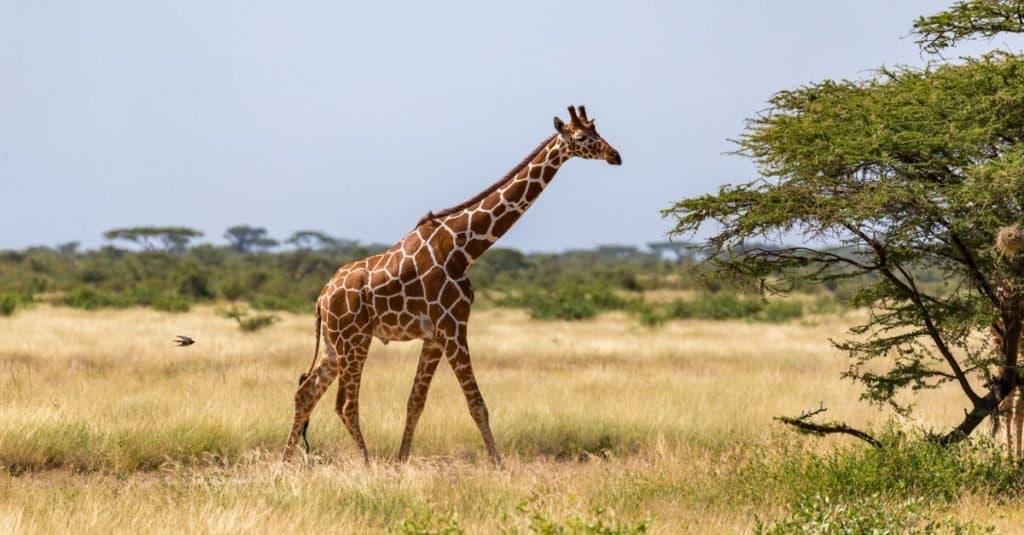
Giraffes use their spots as a form of built-in cooling system.
©Eugen Haag/Shutterstock.com
In addition to serving as camouflage and social markings, spots serve a third, less obvious function. While not obvious, it may also represent one of the most important reasons why giraffes have spots. Anatomical studies of giraffes’ bodies indicate that they use their spots as an intricate method of heat regulation. Specifically, giraffes’ spots help them to release body heat and therefore cool off. Beneath each patch lies an intricate system of blood vessels. A large blood vessel surrounds each patch which then transitions into numerous smaller blood vessels beneath each marking. Giraffes can send blood into the larger blood vessel, which then distributes blood into the smaller vessels in the middle of the patch.
This movement of blood releases heat through the spots, allowing each one to act as a heat reducer. In a way, giraffes contain a built-in cooling system that allows them to prevent their bodies from overheating. Given that they live in some of the hottest and driest climates on Earth, this remarkable adaptation makes complete sense. Giraffes cannot roll around in the mud or dirt to cool off like other animals, due to their long legs and overall shape. So, they developed this amazing heat-reducting system to compensate.
Frequently Asked Questions
Which pattern is the most popular among giraffes?
While all giraffes possess unique markings, each subspecies possess certain traits in common, including marking patterns. Among the subspecies of giraffe, the one with the largest population is the Masai. This would make the Masai pattern the most common among giraffes.
The photo featured at the top of this post is © PLANET EARTH/Shutterstock.com
Thank you for reading! Have some feedback for us? Contact the AZ Animals editorial team.



